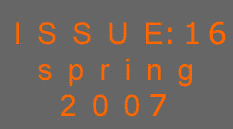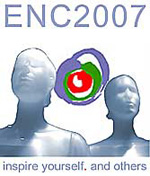

RRFM / IGORR 2007 – the success of synergy!
The IGORR (International Group Operating Research
Reactors) conference took place this year in Lyon, France, from
12-14 March, where it joined forces with the RRFM Conference (Research
Reactor Fuel Management), to create the first ever RRFM/IGORR.

The RRFM is a well-established annual event that
takes place in Europe and focuses on all questions relating to
the management of fuel for research reactors.
The IGORR conference is a biannual event that
brings together experts from all around the world in the field
of research reactor technology. In addition to focusing on the
management of research operators, IGORR also puts the debating
spotlight on the design, construction and operation of new research
reactor types.
The synergy between RRFM and IGORR was perfect
and the two merged into one seamlessly. A total of 290 participants
from 38 countries congregated in Lyon to take part in the numerous
plenary and parallel sessions. Here is a summary of the main highlights
of RRFM/IGORR 2007:
After some introductory words from the two co-chairmen
– Edgar Koonen of SCK-CEN who spoke on behalf of RRFM and
Joël Guidez, Chairman of IGORR and Director of the Pheonix
Plant – a speech was given by the High Commissioner for
Atomic Energy at the CEA (Commissariat à l’Energie),
B. Bigot. Mr Bigot’s speech focused on the social contribution
that nuclear research reactors make in diverse areas such as medical
applications, the irradiation of new materials, developing new
fuels for the nuclear industry, education and training, research
into the structure of mass and nano technologies and defence and
space exploration technologies. One of the new reactor projects
that were presented was the Jules Horowitz Reactor (JHR), which
is currently under construction at Cadarache, France. The JHR
is financed by a consortium of contributing countries that will
benefit from first use of the results of its research programmes.
The Plenary Session on Day 1 of RRFM/IGORR
2007 kicked off with a general overview of the status
of current research reactors around the world. The impressive
planning behind the Australian OPAL reactor that started operation
in 2006 was one focus of attention. A presentation was also given
on the JHR project and how the signing of an agreement by the
consortium partners on 19 March 2007 provided a framework for
an international organisation to carry out the project.
A status report on the construction, in Beijing,
of the Chinese reactor, CARR, was then presented, detailing the
safety profile of the reactor. The CARR reactor should be up and
running in 2008. Delegates were then given an outline of the work
carried out by the ILL neutron beam reactor in Grenoble, France,
which is financed by 13 countries.
Next on the agenda was an appreciation of the
civil applications of Libya’s only research reactor, notably
its use in the fields of the desalination of sea water and the
development of medical radioisotopes.
Delegates’ attention then switched to a
presentation on the current functioning of the CEA’s Pheonix
reactor, in France, and of future Generation IV reactors - especially
rapid sodium reactors. These developments were discussed within
the context of the sustainable development debate because these
reactor types multiply by 100% the use of the uranium, which in
turn avoids any problem of supply and allows thousands of years
of production. What’s more, current research with the Pheonix
reactor highlights how these reactors enable long-lived radioactive
waste to be burnt with only rapidly decaying waste (a few hundred
years) as the end product.
The applied research being carried into these
reactors by international organisations was also discussed at
length by RRFM/IGORR 2007 participants. The IAEA,
for example, presented the work done by its TWGRR (Technical Working
Group on Research Reactors) team. This work facilitates the exchange
of knowledge and expertise, provides technical support and helps
with the elaboration of recommendations.
Participants then focused on various recent works
published on the subject of the Global Threat Reduction Initiative
(GTRI) and the related work carried out across the world to recuperate
and render safe HEU nuclear fuel (an enrichment level of over
20%). This naturally led to a discussion on the latest work being
done to convert reactors to use fuel that is enriched by up to
20% (LEU)
The agenda for the next two days of the conference
consisted of a series of parallel sessions devoted to a range
of specialised topics, in particular discussions about the new
nuclear fuel “UMO” and neutron calculations in reactor
cores. As far as the UMO fuel is concerned, delegates were reminded
that for certain reactor types the conversion from HEU fuel to
LEU fuel leads to an unacceptable reduction in operational efficiency
and a loss of flux characteristics. This fact has in turn lead
to applied research into UMO fuel, which enables greater density
and reduces to a minimum what is lost during the conversion process.
The development of UMO fuel has been hindered in recent years
by difficulties linked essentially to the interaction between
the fuel and the cladding, which has led to the bursting of the
cladding during qualification tests in the reactors. Various rather
empirical methods to overcome the problem of interaction are being
applied (e.g. the addition of silicon to the cladding, the covering
of the fuel, etc.). At present, no valid solution has been, found
and research continues.
Another highlight on the programme was a presentation
on the conversion of reactors, most notably the conversion to
20% silicon of the SAFARI reactor in Africa. Work on this is ongoing.
The estimated loss in terms of neutron flux availability during
the conversion process is around 8%.
Overall, RRFM/IGORR 2007 was
a resounding success, in keeping with the individual reputations
of the RRFM and IGORR conferences.
The next RRFM conference will take place in 2008
in Hamburg, Germany. The next IGORR conference will take place
in Beijing in 2009, either in conjunction with the RERTR conference
or with a conference devoted to research reactors in Asia.
(Joël Guidez - CEZ)
If you need more information on RRFM/IGORR2007
visit the ENS website at: www.rrfm2007.org
|





